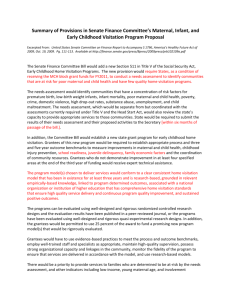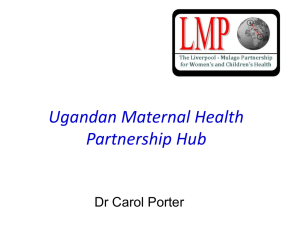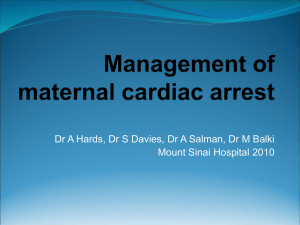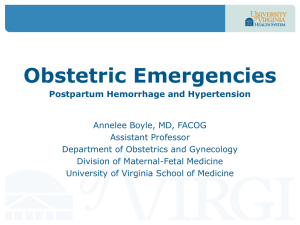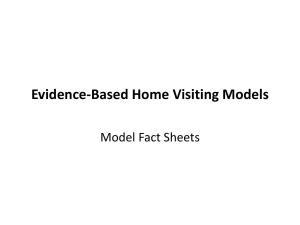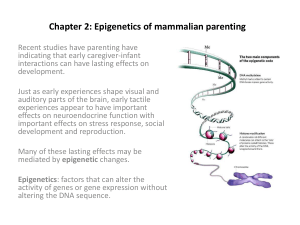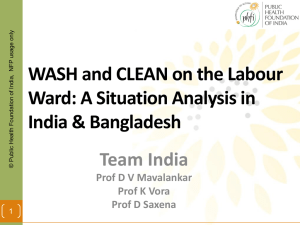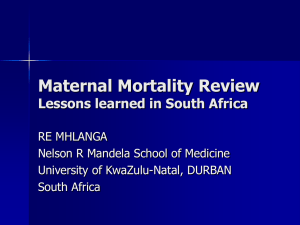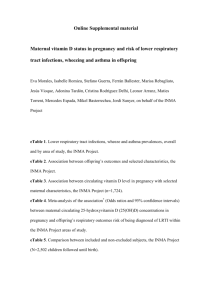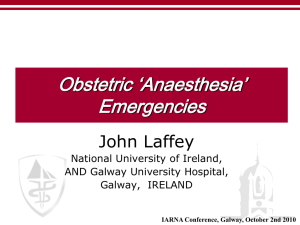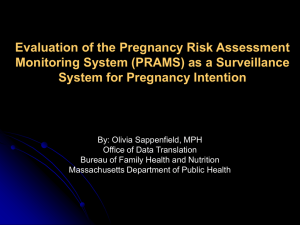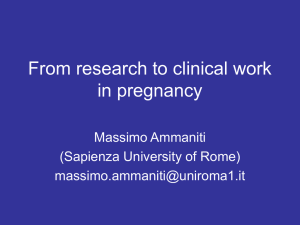Children First Program Tulsa Health Department
advertisement
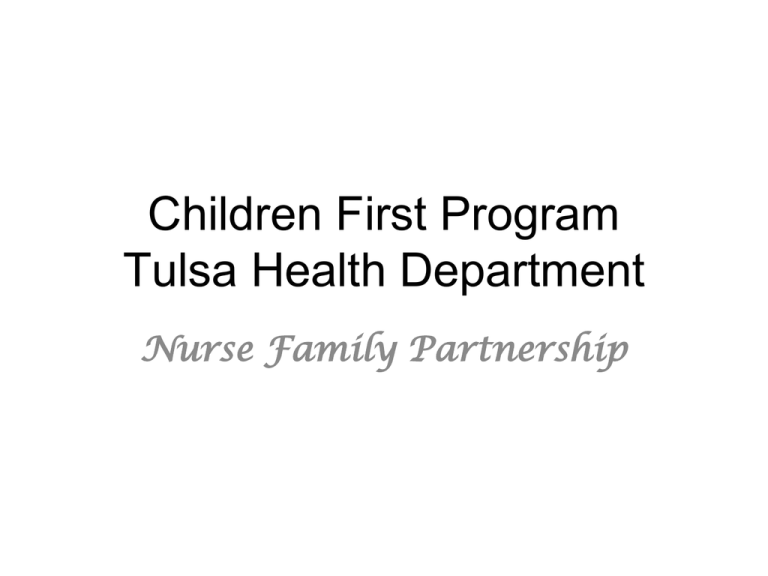
Children First Program Tulsa Health Department Nurse Family Partnership What is our Mission? To promote the health and safety of mothers and young children prenatally and postnatally through public health nurse home visitation. This program focuses on the mother-infant dyad through improvement in maternal health habits, parental behaviors, and the psychological,social and environmental context in which the family is functioning What do we hope to impact? • Improve Pregnancy Outcomes • Improve Child Health and Development • Improve Economic Self sufficiency What is our Vision? Healthy pregnancies… Healthy babies… Healthy families… Healthy communities! Foundational Theories • Attachment (Wind Beneath My Wings) blueprint for how relationships work • Human Ecology (We are Family) environmental influences on individual • Self Efficacy (I believe I can Fly) belief in ability to accomplish & achieve Client Centered Principles 1. 2. 3. 4. 5. Client is the expert on her life Focus on the strengths Follow the client’s heart’s desire Only a small change is necessary Focus on solutions Eligibility Criteria • Less than 29 wks. pregnant (with 1st child) @ enrollment • Income eligible—WIC or Medicaid – Income @ or below 185% FPG • Voluntary enrollment and participation • Reside in Tulsa County or lower 1/3 Osage County Visit Schedule • Begin in Pregnancy--wkly visits X4 then Every other week until delivery • Visit weekly --beginning after delivery X 6weeks • Infancy --every other wk beginning at 8wks • Toddler--every other week until 21 months old--then monthly visits until 24 months. • Graduate @ 24 months Six Domains of Focus • • • • • • Personal Health Maternal Role Environmental Health Family and Friends Life Course Development Health and Human Services Curriculum • • • • • • • Core Curriculum topics Partners In Parenting Education (PIPE) Nursg.Child Assmt Satellite Trng (NCAST) Ages and Stages Questionnaire (ASQ) Motivational Interviewing (MI) Post Partum Depression (PPD) Child Abuse Medical Examiner (CAME) Supervision • • • • • • • • • 1:1 weekly Uninterrupted Supportive Reflective Collaborative/solution focused Safe place Technical Consultation Assist with identifying resources Should mirror relationships w/clients Technology • • • • • • • Laptops/smart phones Electronic referral system HIE/Doc2Doc (coming soon) Social media (Facebook) Texting! (but not while driving!! ) Distance learning/communication THD, OSDH and NFP Websites Quality • • • • • • • Quarterly Record Audits Annual Site Visits Ongoing participation in research Fidelity to NFP Model (evidenced based) Logic model (pathway to outcomes) Annual Cont. Education (OHCA) Mentoring Students Age of Clients FY 2010 18y and younger 19-24 25-34 35 + 32% 52% 14% 1% Race FY 2010 • Caucasian 32% • African American 28% • Hispanic 26% • Native American 4% • “Growing” Burmese Pop. Referral Sources 2010 (n= 565) • • • • • • • • • • Other 34% Babyline 27% Self Referral 14% Family Planning 7% WIC 5% 2011=37% of referrals came from WIC!! Faith Based 4% IHC 4% Private Dr. 2% Current/past Clt. 2% Preg. Test Clinic 1% Data SFY 2010 Enrolled in Medicaid Enrolled in WIC Living at or below FGP Premature Births (<37w gest) Initiate Breastfeeding Report still BF @ 6mo Births in 2010 Graduates 80% 58% 99% 12% 81% 27% n 219 n 103 Children First - Logic Model ASSUMPTIONS INPUTS 1. Program services are guided by literature on primary prevention programs and risk & protective factors of child abuse and neglect that show positive results such as: Registered Nurses with valid Oklahoma licenses with training in the NFP model of home visitation services Prevention programs are most effective when they are tailored to the specific needs of the target population. The timing of the intervention matters. Intensity, duration and regularity of the intervention matters. Programs using modeling, role-playing are nearly twice as effective as programs using non-directive strategies such as counseling and group discussions. Enhancement of protective factors and minimization of risk factors reduces the occurrence of child abuse and neglect amongst children and families. 2. Children First Home Visitation program will utilize the Nurse Family Partnership model to deliver services. •Home visitation programs have been proven to decrease incidence of abuse and neglect of children. Transportation for conducting home visits. -Assess maternal health - Link to health care. - Link to prenatal care. - Educate on consequences of smoking, alcohol and drugs during pregnancy - Identify depression and make referrals. Social services / resources. Partnerships to provide referrals. Stable C1 funding. Clinical and administrative support of county health departments C1 central office staff. Program Evaluation. Program monitoring and contract compliance to ensure program fidelity. NFP Dr. Old’s Model of Home Visitation POPUL ATIO N SERVE D Women from all 77 Oklahoma counties who are: •At or below 185% of the Federal Poverty Level •Less than 29 weeks gestation •First time mothers SHORT-TERM OUTCOMES-Objectives OUTPUTS-Activities - Assess child health - Link to health care. - Conduct developmental screenings and make referrals. - Promote breast-feeding. - Educate about nurturing home environments. - Educate about the effects of smoking around the child. •Educate about the effects of domestic violence around the child. - Demonstrate positive parenting techniques - Assist in building skills for problem solving. - Assist in building skills for finding and linking to appropriate community resources. •Link to community services, as needed. •Encourage appropriate stress –coping mechanisms. •Promote and increase father involvement. -Refer to employment or education resources. • Educate on family planning and contraceptive use - Provide positive role model for parentchild interaction. - Provide referrals to public assistance programs when appropriate. - Educate on safe practices and safe home environment such as water, fire, vehicle and wheeled toys safety; poisons, child-proofing home,abusiv e head trauma and safe sleeping practice. - Educate on domestic violence. - Assess risk of child maltreatment. Perinatal Health • Decreased incidence of STD and UTI among clients during pregnancy • Decreased emergency room usage • Appropriate weight gain • Early recognition and referral for Post Partum Depression Health Behaviors • Smoking Cessation • No alcohol usage • No substance usage Appropriate prenatal obstetrical care • Increase in clients receiving 10+ prenatal visits Infant Health • Increased breastfeeding initiation and duration • Decreased time spent in NICU, if necessary • Increased gestational age at delivery • Decrease in preterm births Toddler Health • Immunizations up-to-date • Well Child Checks up-to-date • Decreased emergency room visits due to illness • Appropriate growth patterns Maternal Health To enhance mother’s health throughout pregnancy and after delivery to ensure adequate care and referrals if necessary. Infant/Toddler Health & Development To enhance healthy growth and development. Paternal Involvement •Increase paternal involvement during pregnancy, infancy and toddlerhood •Increased communication between mother and father •More Positive Parent-Child Interaction Child and Maternal Living Arrangement •Increased stability of living arrangement for mother and child Family Stability To enhance family functioning by establishing a trusting, nurturing relationship, improving family support systems and teach problem solving skills. -Subsequent Pregnancy Spacing and Family Planning •Increased interval between pregnancies, increased use of contraception -Workforce Participation •Increased participation in workforce by clients over 18 -Continuing Education •Increased enrollment and attendance of educational or technical program -Appropriate use of Public Assistance programs Increased use of services available as appropriate Maternal Life Course Development To promote achievement of personal goals in employment, education and personal health. Decreased usage of emergency room due to injuries Home Safety Checklist Safe Sleep Practices •Increase in safe sleep practices Car Seat Safety •Increased car seat usage Decreased confirmations of abuse or neglect to OKDHS Decreased exposure to home violence •Voluntary Participants Rev: Nov 09 LONG-TERM OUTCOMES-Goals Family Safety To promote safe practices and reduce the risk of injury, illness, abuse and neglect. Children First GOALS COLOR GUIDE Yellow: Maternal health Purple: Child Health & Development Blue: Family Stability Pink: Maternal Life Course Development Gold: Family Safety Resources Nurse Family Partnership website www.nursefamilypartnership.org Tulsa Health Department website www.tulsa-health.org Oklahoma State Department of Health website www.ok.gov/health



